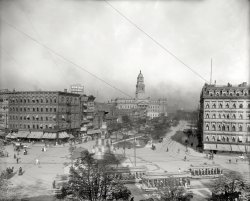
MAY CONTAIN NUTS

Search Shorpy
SHORPY ART

Framed or unframed, desk size to sofa size, printed by us in Arizona and Alabama since 2007. Explore now.
Join and Share
Ad-Free Shorpy
Shorpy is funded by you. Patreon contributors get an ad-free experience.
Learn more.

Recent comments
- Baldwin 62303
- Baldwin VO-1000
- Cold
- No expense spared
- Tough Guys
- Lost in Toyland
- And without gloves
- If I were a blindfolded time traveler
- Smoke Consumer Also Cooks
- Oh that stove!
- Possibly still there?
- What?!?
- $100 Reward
- Freeze Frame
- Texas Flyer wanted
- Just a Year Too Soon
- WWII -- Replacing men with women at the railroad crossing.
- Yes, Icing
- You kids drive me nuts!
- NOT An Easy Job
- I wonder
- Just add window boxes
- Icing Platform?
- Indiana Harbor Belt abides
- Freezing haze
- Corrections (for those who care)
- C&NW at Nelson
- Fallen Flags
- A dangerous job made worse
- Water Stop
Member Photos
The Shorpy
Print Emporium
Print Emporium
Search Shorpy
Search results -- 30 results per page
- Winter Crossing: 1900
- Circa 1900. "Detroit River. Car ferry Michigan Central entering slip." 8x10 inch dry plate glass negative, Detroit ... on the frozen river, on the way back to Windsor from Detroit, smuggling back cotton socks. She would have been 10 years old.
... Posted by Dave - 08/02/2012 - 3:18pm -
![Winter Crossing: 1900 Circa 1900. "Detroit River. Car ferry Michigan Central entering slip." 8x10 inch dry plate glass negative, Detroit Publishing Company. View full size.
Who's with me?Winter break on the Detroit River!
Frigid WonderThis is just a beautiful photo, of an otherwise thoroughly utilitarian scene, just barely romanticized by having train cars and a paddlewheeler as subject matter.
The texture in the broken ice at foreground, the impressionistic smoke, and mist in the distance -- Wow.
Brr.I'm getting frostbite just looking at this picture.
All aboardI see the three sets of tracks, but would like to see the actual way they load and unload the box cars. I bet the guy smoking the pipe could have told us.
Extraordinary!This is an extraordinarily beautiful photo. The black and white textures are remarkable. I can feel the cold air and hear the ice crunching as the ferry drifts in. The ghostliness of the image is echoed in the misty distant skylines, and the whole is anchored by the two figures.
What a composition!
SkylineDoes anyone know if the ferry is pulling into Detroit or Windsor? Any clue from the church in the distance?
Interesting weatherCloudy, with a 100% chance of thumbprints!
Link & PinThe center car seems to be fitted with a link & pin coupling. The Railroad Safety Appliance Act took effect in 1900 outlawing these hand crushers on railroads engaged in interstate commerce.
Absolutely wonderful!As a person who lived in Archangelsk city, I used to see a scenes like this many many times. I feel the atmosphere, I even can feel a smell of it. Wonderful! Just great!
"Michigan Central"This seems to be the same sidewheeler design as in the previous shot of a car ferry, the "Transport." The names (hard to see) are stenciled on a signboard over the wheelhouse.
A ferry wonderland"The Great Lakes Car Ferries" by George Woodman Hilton has another photo of the Michigan Central on page 35.
Best. Photo. Ever.I've been reading Shorpy regularly since sometime in '07 when I saw a link on either Boing Boing or Neatorama. This is abso-freakin-lutely the Best. Photo. Ever. Bless you, and keep doing what you do.
Over the riverAt about this time, my grandmother may have been on a sleigh on the frozen river, on the way back to Windsor from Detroit, smuggling back cotton socks. She would have been 10 years old.
Such was the family story.
Great photoI am so impressed with the high contrast in the sky. If it were not clearly labeled as a scan directly from the negative, I would have assumed this was a print which had received a lot of attention in the darkroom.
This image is one of Shorpy's all time greats.
[All of the images on this site are adjusted for contrast in Photoshop. - Dave]
57 summers laterBelow is a scan of a 35 mm Kodachrome slide showing this same rail car ferry yard as it looked on July 6, 1957. The photo was taken from the deck of the Ambassador Bridge and its viewpoint is 180 degrees from that of the 1900 photo (the bridge was built during 1927-1929). View full size.
The church steeple seen in the distance on the 1900 photo is located in Windsor, Ontario. Here's a photo of it taken from the bridge deck just seconds prior to the one of the rail car ferry yard in Detroit.
Jules VerneyUntil you focus in on the rail cars, and the pictures resolves into the recognizable, there's a kind of Victorian Future-Shock quality to it.
Frozen in timeThe sharpness of the broken crystal shards could kill a man, they stand pointed end up, ready to cut a careless worker or walker, like razor-edged beveled glass. Two men are seen, yet each is lost in their own solitary thoughts. Possibly thinking "damn, it's cold."
Final departureIt looks like they are taking boxcars full of the damned over the river Styx.
The church might be in WindsorIt looks very much like Our Lady of the Assumption Church near the foot of Huron Church Rd. It is still there, presently in the shadow of the Ambassador Bridge.
If so, the view is downstream.
Detroit RiverThis is the Detroit side. The river flows extremely fast, and the ferry docks were set up so the boats always entered dock facing upstream. Michigan Central was built in 1884 by Detroit Dry Dock in Wyandotte, while Transport was built there in 1880. Both were cut down to barges by the 1930's. A nearly identical boat, Lansdowne of 1884, survived in steam until 1970 for CN/Grand Trunk, until she blew a cylinder head (I remember the shock among the Detroit trainwatching community at the time).
Her long survival was due to the limited size of the RR tunnels under the river, which couldn't handle hi-cubes and other large cars.
Lansdowne then became a floating restaurant, with two Milwaukee Road Skytop observation cars aboard. Recently scrapped in Buffalo.
I frequently went down to watch Lansdowne and an even older propeller ferry in the days of no security, "Sure, just be careful!"
WindsorI live in Amherstburg, about 20 miles downriver from Windsor. I love these photos of the Detroit River.
Great StuffI love these pictures of the Detroit River railroad ferries. My grandfather worked on these boats when he first came to Detroit from Pennsylvania in 1919. I remember watching them shuttle across the river during my childhood in the '60s and '70s.
Does anyone know what that factory on the right is? Is it the Michigan Peninsular Car Co. (aka American Car & Foundry)? It seems to be in basically the right place on the west side of Detroit. My great-grandfather, on the other side, worked there.
Building a ModelI'm building a 1/87 model of the train ferry Windsor, and these pictures and diagrams have proven to be invaluable.
Thanks, Terry Jolliffe
Belle River, Ontario
(The Gallery, Boats & Bridges, DPC, Railroads)](https://www.shorpy.com/files/images/4a04912a1.thumbnail.jpg)
- Michigan Avenue: 1918
- Chicago circa 1918. "Michigan Avenue -- Blackstone Hotel and Grant Park." 8x10 inch dry plate glass ... street lamps are still in use today.
Original Michigan Blvd. Lampposts The unique originals were replaced in the '50's by ... Posted by Dave - 10/27/2015 - 10:48am -
![Michigan Avenue: 1918 Chicago circa 1918. "Michigan Avenue -- Blackstone Hotel and Grant Park." 8x10 inch dry plate glass negative, Detroit Publishing Company. View full size.
Trees, please. Thank you.
Amazinglythose multi-globed street lamps are still in use today.
Original Michigan Blvd. Lampposts The unique originals were replaced in the '50's by a bland street lighting design eventually used throughout the city. These 50's replacements are still in use in most areas in Chicago proper. Later use of sodium vapor in the lighting elements, these newer fixtures have contributed to the "Orange-ing" of Chicago which sets the city streets apart from those of the suburbs.
Even though these replica lampposts use sodium lamps (orange), I was glad to see them return!
Still looks beautifulFunny, with the decline of Detroit in the news so much I was expecting this hotel and entire block to be gone or abandoned. It's nice to see that the hotel appears to be as beautiful as it was in 1918.
[This is Chicago, though. -tterrace]
Oohh...Detroit PUBLISHING company. Thanks tterrace. I saw Detroit at the bottom in the description and got it in my head. Thanks for setting me straight. I had a moment of hope for Detroit! :)
+89Below is the same view from April of 2007.
Art Institute of ChicagoThat would be the Art Institute in the distance on this side of the street - also still there in the same building.
Stick It To 'EmThe billboard to the left of the Blackstone advertised Thrift Stamps that were being sold to the public to aid the Liberty Loan drive during WW1. They sold for 25 cents each.
and could eventually be traded for interest bearing War Bonds. We had similar stamps during WW2 but they could be purchased for as low as a dime.
BlackstoneI have stayed there a few times, actually. Neat old building. A ton of movies were filmed there too!
(The Gallery, Chicago, DPC)](https://www.shorpy.com/files/images/SHORPY-4a24940a.thumbnail.jpg)
- The Detroit: 1905
- ...
Volume 19, 1905.
Car-ferry steamer "Detroit": Michigan Central Railway
A four-screw car-ferry steamer of exceptional ... River service of the Michigan Central Railway (between Detroit, Mich., and Windsor, Ont.). The railway company has four car-ferry ... Posted by Dave - 08/05/2012 - 3:27pm -
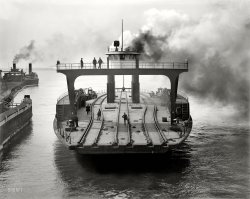
- Green Detroit: 1942
- Detroit, July 1942. "Looking north on Woodward Avenue from the Maccabees ...
Old Detroit 87 years ago today I was born in Detroit, Michigan. Detroit was a tree city. I remember going to the top of the downtown ... Posted by Dave - 07/30/2012 - 10:52am -
![Green Detroit: 1942 Detroit, July 1942. "Looking north on Woodward Avenue from the Maccabees Building with the Fisher Building at the distant left, and the Wardell Hotel at the right." 4x5 Kodachrome transparency by Arthur Siegel. View full size.
Detroit Institute of ArtsIn the foreground, the building to the right (cut off) is now the home of the Detroit Institute of Arts. The building on the left is the Detroit Public Library.
It's strange to see all the trees in the photo. Those are sadly not there anymore.
My Old NeighborhoodI went to college and lived in this neighborhood about a block out of frame to the right. Most of the major buildings in the picture are still there today and look much the same. The Detroit Institute of Art has just finished up a Michael Graves redesign of the 1960s and 70s additions that wrap around the back of the original central building seen here. The DIA atrium contains Diego Rivera's famous Detroit industry murals. The main branch of the DPL on the left is by Cass Gilbert with a later rear addition by his son.
The streetcars are gone of course, but there are groups working to bring them back to this part of Woodward Avenue.
Charles Lang Freer's Mansion is hidden behind the three-winged Wardell (now Park Shelton) Hotel. The Freer Mansion, one of the most important Shingle Style residences in the country, once contained the famous Peacock Room designed by Whistler, later relocated to the Freer Gallery in Washington.
The smokestacks next to Woodward just at the horizon were at the now demolished powerhouse of Ford's Highland Park factory.
Old Detroit87 years ago today I was born in Detroit, Michigan. Detroit was a tree city. I remember going to the top of the downtown sky scrapers and was surprised at seeing so many trees in the city.
[Happy birthday, Seattle Kid! - Dave]
Parade routeDitto anonymous tipster, I worked at that library, attended Wayne State University which is (will be) off to the left, and this side of the photographer.
Site of the Hudson's Thanksgiving Day Parade.
Still a Jungle Out ThereSeattlekid, you still can see the treetops from many buildings. I went up in the abandoned Michigan Central Station and after looking at the pictures, you'd think Detroit was all trees. On another note, look at how nice Woodward Avenue actually looks. Nowadays, if you try riding your bike on it you're certainly taking your life into your hands.
Home Sweet HomeJust across Woodward from the Wardell/Park Shelton, in that grove of trees, you can see a roof with several chimneys. 14 years after this picture was taken, I was born in that building, Called the Art Centre Hospital. It later became part of the Detroit Historical Museum, and is now, I believe, part of Wayne State University.
DetroitI was one of the artsy folk over at the College for Creative Studies, but several of my cousins went to Wayne State. The Public Library is really something. My film-major roommate used the grand stairway and second-floor hall as sets for as a fairy tale style palace in a short film he was making.
Clang Clang ClangI lived about a half mile south of there on Woodward a few years back - walked to the library all the time, but it's the trolleys that get me - how cool that must have been.
The Pontiac SignMakes me think of all the GTO's that will help turn this avenue into a street racing legend 20 odd years later. Or was it Woodward Boulevard? Well, what does a hick from Georgia know about Michigan?
Foy
Las Vegas
Woodward AvenueAerial view.
Although MS Live Maps doesn't allow me to view at the same angle, it's still interesting to look at the layout of the area ~66 years later.
Detroit trees and streetcarsSadly, most of Detroit has lost the beautiful American elm trees over the last few decades due to Dutch Elm Disease. I remember the early a.m. spraying helicopter flights over our northwest Detroit neighborhood in the early sixties as the city tried to control the blight. I wonder how many later sicknesses and chronic conditions were caused by all of us breathing the aerial sprays.
In 1970 while working for the DSR (Detroit's bus company), many old time executives told me detailed stories about the streetcars' demise in the 50's. Most of the tales had to do with the auto executives refusing to allow room for tracks within the newly planned expressways (freeways) to the Willow Run auto plant during WWII. One was quoted as saying that he'd be damned if his employees would be taking a streetcar to work instead of buying and driving one of the cars that they made. I think they were sold to Mexico City where they still faithfully ply the rails.
The City BeautifulA few months ago, I was on a road trip from Toronto to Ann Arbor. We went south instead of north (can't remember the road) and ended up driving into Detroit. I was thrilled. The architecture is amazing. I plan a trip soon to visit and photograph these incredible buildings. I'm putting the DIA, the DPL and the Freer Mansion on the top of the list.
I'm rooting for those tracks to be brought back too.
Streetcars and treesA lovely pic of Detroit; if you want to actually be in a city with hard-working streetcars and a blanket of trees go to Toronto, just a few hours east of this view. With a few glass skyscrapers now added one gets the impression of a prosperous, pre-1940 American city, with a dose of peace, order and good government -- sort of a motto there.
Woodward Dreaming CruiseWe used to ride the streetcar down from the 8-Mile Palmer Park area by the State Fairgrounds to go shopping at the big J.L.Hudson department store in downtown, farther south from this photo.
The last day of service of the streetcars they put on several extra cars for a "one last ride" experience. My father took me along and we rode that last trip into the sunset. I got to see Canada across the river and was tremendously impressed at being able to actually see a whole different country.
Still don't know how we got home, if that was the last trip!
About those GTOs on Woodward Avenue. That all happened way farther north from here off into the distance at the top of the photo, starting at 11 Mile Road in Royal Oak (where I lived later on) and racing from stoplight to stoplight (about every half mile) up to about 15 Mile Road in Birmingham. I learned to drive a half mile at a time -- but very quickly.
Detroit, my hometownWayne State University was (and still is) located to the left of what this photograph shows. When this photograph was taken, however, the university was known as Wayne University and was actually operated by the Board of Education of the city's public school district. The word "State" was added to the university's name in the 1950s when it joined Michigan's other main state-supported schools--the University of Michigan and Michigan State University.
In the upper left-hand corner of the photograph two of legendary architect Albert Kahn's edifices can be seen. The tall building is the Fisher Building, so named for the Fisher brothers (of Fisher Body fame) who commissioned it. Immediately in front of, and to the right of, the Fisher Building is what was then known as the General Motors Building. This edifice, which was the world's largest office building when built in the late 1920s, housed the carmaker's main offices until the late 1990s when the automaker moved to its present home in downtown Detroit. Today, the former GM Building is known as Cadillac Place and houses various State of Michigan government offices and courts.
(The Gallery, Kodachromes, Arthur Siegel, Detroit Photos, Streetcars)](https://www.shorpy.com/files/images/1a35409u.thumbnail.jpg)
- Factoryville: 1910
- ... Company was based there. Henkel's Flour was out of Detroit, but I think there was an outpost in Cleveland, too.
Gritty City ... Detroit I'm going to take a wild guess and say Detroit, Michigan. That looks like Henkel's Flour mill sign in the background.
... Posted by Dave - 05/09/2014 - 5:10pm -
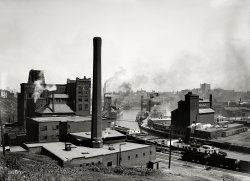
- Chicago Club: 1906
- ... Romanesque building at the southwest corner of Michigan Ave. and Van Buren St. was designed by Burnham and Root and built in ... into its present headquarters two blocks up and across Michigan Avenue in 1893, the building was sold to the Chicago Club. As the ... Wing (street cleaner) with his broom in the foreground
Michigan Avenue or Boulevard? We see here, from left to right, at #:
203 ... Posted by Dave - 09/07/2012 - 12:26pm -
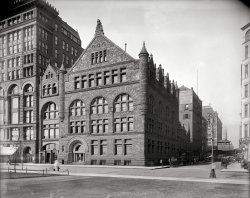
- Toledo: 1909
- ...
Toledo and Ohio Central and Kanawha and Michigan were both absorbed by New York Central System. NYC as part of Conrail, ... Southern and CSX Trans.
Hocking Valley, Kanawha and Michigan and Toledo & Ohio Central and ... lots of Hocking Valley Railway , Kanawha and Michigan Railroad and Toledo and Ohio Central Railroad train cars to be ... Posted by Dave - 10/22/2011 - 7:24am -
![Toledo: 1909 Toledo, Ohio, circa 1909. "Maumee River waterfront." 8x10 inch dry plate glass negative, Detroit Publishing Company. View full size.
Long gone railroadsThese railroads are so long-gone, that the companies that took these over are also long-gone.
Hocking Valley Ry became part of Chesapeake and Ohio, which is in turn part of today's CSX Transportation.
Toledo and Ohio Central and Kanawha and Michigan were both absorbed by New York Central System. NYC as part of Conrail, was split up between Norfolk Southern and CSX Trans.
Hocking Valley, Kanawha and Michigan and Toledo & Ohio Centraland ... lots of Hocking Valley Railway, Kanawha and Michigan Railroad and Toledo and Ohio Central Railroad train cars to be seen.
Toledo? You ask how I know of Toledo, Ohio,
Well, I spent a week there, one day
They've got entertainment to dazzle your eyes
Go visit the bakery and watch the buns rise.
Code BreakerI wonder if all transmissions aboard the Jay C. Morse are done in code.
Spotted over above right, a roof hoarding advertising the Snow Flake Laundry, what a great name, hopefully not too indicitive of the weather patterns in Toledo.
Jay C. MorseThe ore freighter is named for the industrialist co-founder of one of the era's most powerful steel and mining companies (Pickands, Mather & Co.). In 1899, at age sixty, Jay Morse married Seville Hanna, the widow of his business partner James Pickands and sister of the sitting president's "Karl Rove," Mark Hanna. Morse died August 22, 1906, and on July 21, 1907 his widow helped to launch the steamship bearing his name.
Is it live, or is it Memorex?Please excuse the audio reference to obviously visual dilemma.
This looks like the most awesome HO train setting I've ever seen!
SS. Jay C. Morse Photographed here in her first year on the lakes, the Jay C. Morse, AmShip Cleveland hull #438, was in service for over seven decades. After a final few years as a lowly storage barge, she was scrapped in the 1980s. Her wheelhouse, removed prior to commitment to the scrapyard, was saved and made into a maritime museum in her last port, Goderich, Ontario. Comparison of the the 1908 photograph with the preserved wheelhouse/museum indicate either substantial rebuilding of the bridge or complete replacement during some mid-life refit.
Boatnerd.com has a 1980 photo of her during her final years as a grain storage barge.
The Scanner, Toronto Marine Historical Society, 1978.
The bulk carrier Jay C. Morse which was acquired early in the spring of 1965 from the Interlake Steamship Company and renamed Shelter Bay (II). After operating Shelter Bay for the 1965 season, Q & O [Quebec And Ontario Transportation Co.] decided that the ship was in need of reboilering. It was not thought that the cost of new boilers for such an elderly vessel could be justified and so Q & O searched for some good used boilers which might be obtained at a more reasonable price. The company did not have far to look and decided to purchase from Marine Salvage Ltd. the boilers which were then ensconced in Bayton.
In due course, workmen went aboard Bayton and commenced pulling apart the old girl's after cabin. Her stack removed and a hole chopped down through her upper decks, the Babcock and Wilcox water tube boilers were lifted from the vessel and were carted 'round to the West Street Wharf in Port Colborne where Shelter Bay was lying. During the summer of 1966, the boilers were installed in Shelter Bay and she has operated with them ever since. Q & O, however, might better have searched elsewhere for boilers rather than taking third-hand equipment for the conversion. In recent years, Shelter Bay has been plagued with boiler problems and a particularly nasty spate of difficulties during 1977 threatened to send the boat to the scrapyard. She was reactivated in 1978 for one further year of operation but continued struggles to keep the well-worn boilers in serviceable condition are almost certain to bring the ship to the end of her career at the close of the current navigation season.
The Scanner, Toronto Marine Historical Society, 1979.
The latter steamer [Shelter Bay (II)] went to Goderich last autumn with storage grain and was sold to the Goderich Elevator and Transit Company Ltd. for use as a storage barge. She was briefly renamed Shelter B. (perhaps unofficially) but has since been rechristened D.B. Weldon (II).
The Lightship, Port Huron Museum, 1999.
[Shelter Bay of Q & O] would become the D.B. Weldon (2) and, in 1981, her forward cabins and wheelhouse would be removed to become the Maritime Museum now in display at the harbor [Goderich, Ontario].
(The Gallery, Boats & Bridges, DPC, Railroads, Toledo)](https://www.shorpy.com/files/images/4a19192a.thumbnail.jpg)
- Pennies From Hancock: 1905
- Hancock, Michigan, circa 1905. Another look at copper country. "A modern smelter." With ... you need him Where has that errand boy gone to now?
Michigan Smelter This is the Michigan Smelter at Cole’s Creek, west of Houghton (canal road), albeit the ... Posted by Dave - 12/02/2020 - 2:55pm -
![Pennies From Hancock: 1905 Hancock, Michigan, circa 1905. Another look at copper country. "A modern smelter." With contemporary cows and a bleeding-edge bakery van. 8x10 inch dry plate glass negative, Detroit Publishing Company. View full size.
Never around when you need himWhere has that errand boy gone to now?
Michigan SmelterThis is the Michigan Smelter at Cole’s Creek, west of Houghton (canal road), albeit the photo says Hancock.
[As shown in the photo, Hancock looks slightly closer despite being on the opposite shore. "Pennies From Houghton" certainly sounds better! - Dave]
Making tracks for the Copper RangeA new railroad name to me, I looked up the Copper Range. Dissolved in 1972, it ran 60 miles of trackage from Calumet to McKeever, Michigan. The copper mines it serviced in the Keweenaw Peninsula were called the Copper Range. There is a Copper Range railroad coach car number 60 in a museum but alas, I don't see that one in the photo.
Copper Range RRCheck out the late Kevin Musser's excellent site on the Copper Range . It includes Kevin's plans and efforts for modeling the COPR.
Kevin's family maintains his old site since his death as a memorial for him; it really is excellent.
(The Gallery, DPC, Mining, Railroads)](https://www.shorpy.com/files/images/SHORPY_4a13098a.thumbnail.jpg)
- Cunningham Drugs: 1942
- ... View full size.
Cunningham Drugs, based in Detroit Michigan Cunningham Drugs was a chain of stores founded in 1889 operated primarily within the state of Michigan. I remember them well from my childhood in Detroit. They had a soda ... Posted by Dave - 03/23/2021 - 5:37pm -
![Cunningham Drugs: 1942 UPDATE: The view here is of Douglas Street in beautiful Victoria, British Columbia!
The slide mount for this street scene -- the latest (and earliest) Kodachrome from hotrodder-shutterbug Don Cox -- is bereft of notation regarding location. Where are we? View full size.
Cunningham Drugs, based in Detroit MichiganCunningham Drugs was a chain of stores founded in 1889 operated primarily within the state of Michigan. I remember them well from my childhood in Detroit. They had a soda fountain and served a great hamburger. Michigan locations closed and reopened as Apex Drug in 1982 and were later sold to Perry Drug Stores. They finally sold to Walgreens in 1991. Tip of the hat to Wikipedia.
[Wrong Cunningham Drug. - Dave]
https://en.wikipedia.org/wiki/Cunningham_Drug_(Canada)
Northwest Corner of Douglas and Yates, Victoria, BThe building is still there, minus the top of the turret: https://goo.gl/maps/kPwwNQzq1MXjcAM2A
Location for 3/21 photoI found mention of a Cunningham Drugs in Victoria, British Columbia. There was a postcard on ebay with the words "Peter-Pan-Cunningham-Drugs-Douglas-St-Victorai-British-Columbia-postcard-1950s". The bus' destination in this photo says "Burnside Marigold" which is an intersection in Victoria.
Never ...ever step back to admire your work.
Victoria British ColumbiaAppears to be 1300 Douglas Street.
We're in CanadaTo be more precise, we're in Victoria, British Columbia. Cunningham Drugs on the corner was located at 1300-1306 Douglas Street; the building still exists, the drugstore does not.
Victoria, B.C.Next to Cunningham Drugs is McLean's Bakery, which was located at 1304 Douglas Avenue in Victoria, British Columbia, Canada.
Here is the Google Street View of these storefronts as they appeared in May 2018.
Something tells meThis is British Columbia's capital city, beautiful Victoria.
Victoria BCDouglas and Yates in Victoria, B.C Canada!
Tags + KodachromeThese two together narrow the probable date range to 1946-47. Almost all photographic film and equipment, at least in the US where Kodachrome was made, was reserved for the "war effort". Consumers had difficulty purchasing any photographic materials until well into 1946.
When my dad came back from the war, he wanted to buy a new camera to replace the one he inherited from his father who used it during WW1. He had to wait until 1947 before the Kodak Vigilant 620 was available with the faster f/4.5 lens he wanted. Only the version with the simpler f/6.3 lens was available earlier, and that not until 1946.
[This exposure is from a batch of slides taken in the Pacific Northwest, many of them dated 1942. Don Cox was a Navy photographer's mate. One of his previous images is this Kodachrome from 1943. - Dave]
Good info. A Navy photographer's mate would have had access to materials, Kodachrome in this case, that the average civilian wouldn't have had.
Victoria, BCI believe this to be Victoria, British Columbia - Cunningham Drugs was a well known chain in BC during this time and Burnside/Marigold on the bus is another clue - Burnside Rd, Marigold Park.
Location Victoria Island Coach Lines LTD. The street sign Points to Sidney, BC.
Looks like it's Victoria BCThe bus company initials - Vancouver Island Coach Lines Ltd. (15 November 1928 - 1950) and street sign pointing us to Sidney, which is where the BC Ferries now dock, tells me this is probably Victoria, BC.
Not Danforth & Pape... but rather Douglas & Yates, in Victoria, British Columbia:
Douglas Street runs concurrent with Trans-Canada Highway 1 in Victoria. In fact, the Zero Mile Monument is not far from this intersection.
North of the BorderA quick search for that Burnside-Marigold bus brings up an archival photo from Victoria, B.C.: https://search-bcarchives.royalbcmuseum.bc.ca/burnside-marigold-bus-on-b...
Victoria, British ColumbiaThis picture is taken at the corner of Douglas and Yates in Victoria, B.C. Google streetview shows that most of the block is still there. Names like "Copp the Shoe Man" and "Cunningham Drugs" were well known B.C. companies. I worked for Cunningham Drugs for a while as a teenager in the 1970s.
The bus in the picture is Vancouver Island Coach Lines and its route is Burnside - Marigold. And the dark blue sedan in the middle of the street looks like it might be a 1929 Auburn.
Looks to me like ...Vancouver, B.C.
Found itThe location is 1302 Douglas Street in Victoria, British Columbia (corner of Yates and Douglas). The spire and the some of the parapet on top of the Cunningham Drug store are gone now but otherwise the street is remarkably the same.
"For the unrelated Canadian chain, see Cunningham Drug (Canada)."
TagsThe only years B.C. did not use front license plates were 1942 thru 1947, as a wartime metal conservation effort. So we can date this photo from during World War II or just after.
Douglas Street, Victoria B.C.Cross' Marketeria was at 1310 Douglas in Victoria, BC. Here's what it looks like today:
Douglas Street, Victoria, BC, Canada?Just a guess. I know United Cigar Stores LTD was a Canadian retailer, V.I.C.L., Ltd on the bus I guess to mean something like Vancouver Island Coach Line, the direction sign points to Sidney which is a town near Victoria, Douglas Street seems to be a good main drag downtown to put hotel on. St James Hotel counters my reasoning but you can’t have everything.
At the far right ...... we see the Douglas Hotel at 1450 Douglas Street and the Victoria City Hall at the corner of Douglas Street and Pandora Avenue, an example of Second Empire-style public architecture.
That 'scaffolding'The day before OSHA was created.
Accident waiting to happenWow. Two men on a sagging scaffold with people under it.
Rock steady!Is there any way to know whether Don Cox used a tripod for his photos? If not, then he could certainly hold still when he needed to.
Laurel and Hardy on locationI don't recall Cunningham's signs being any color but green, maybe it is a Canadian Thing.
The sign painters' physiques, the bow in the scaffold plank, the can of paint and the pedestrian below in trench coat and hat. It is a fine line between tragedy and comedy.
Curiously familiarThis looks very much like R Crumb in Kodachrome.
(Most) Trades workers of YoreSeemed to survive:
No hard hats
No gloves
No safety harnesses
No safety goggles
No ear protection
No high visibility jackets
No steel capped boots
No traffic and pedestrian control monitors
No pedestrian bypass barriers
No proper scaffolding
No safety inspectors
No license (usually) required to close off part of street/sidewalk
No dust or chemical spill controls
(The Gallery, Kodachromes, Cars, Trucks, Buses, Don Cox, Stores & Markets)](https://www.shorpy.com/files/images/SHORPY-P-0020.thumbnail.jpg)
- Detroit of Detroit: 1904
- Ecorse, Michigan. 1904. "Steamer Detroit , Michigan Central transfer, stern view from under." 8x10 inch glass negative, ... Posted by Dave - 08/21/2012 - 1:21pm -
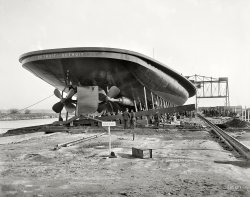
- A Big Load: 1890s
- Michigan circa 1890s. "Logging a big load." Continuing our Michigan travelog. 8x10 inch dry plate glass negative, Detroit Publishing ... Here are a couple photos I used in our project about Michigan White Pine Lumbering in the mid 1800's.
Logging in Upper Michigan ... Posted by Dave - 07/29/2012 - 10:08am -
![A Big Load: 1890s Michigan circa 1890s. "Logging a big load." Continuing our Michigan travelog. 8x10 inch dry plate glass negative, Detroit Publishing Company. View full size.
IncredibleThis picture blows my mind. On the one hand, my first inclination is to call it a gag photo. But there it is -- before the days of Photoshop. On the other hand I am left to wonder: How can two horses pull such an enormous load -- on sled runners no less, in snow-covered dirt? All the lumberjacks present suggest we are at the forest, not the mill. How long is the horse-pull to the mill? How were the logs piled so high? I take it there was a steam derrick somewhere abouts. etc. etc. People want to know, Dave.
Can't resistThose lumberjacks sure have a lot of wood.
Hardly toothpicksHope that load didn't become firewood. Can't tell the species from the bark, but that's marvelous timber -- straight, free of limbs (and, thereby, knots and/or crotch wood) -- and some of the logs must be approaching 3 feet across. I see lots of furniture there.
I'm SpeechlessThese guys are nuts!
2 HPI'm surprised that kind of load can be pulled by only two horses. Hope they don't have to pull it uphill.
PuzzledHow the heck did they stack those logs that high?
How the heck do just two horses pull that load?
Regardless, pretty darned impressive.
Special ShoesThe horses were generally shod with special "clawed" shoes--sort of studded tires of the day. This gave them extra grip in the ice and snow. Also, it would be easier to drag this over the ice (once it was moving)than over dirt roads.
I am a native Oregonian and remember seeing trees like this going through the small towns of my childhood on the back log log trucks.
Maybe the Run is Downhill?But surely even these brawny experts didn't saw the logs so neatly by hand, so there must be a steam-driven saw and crane nearby.
[The trees were felled and sectioned by hand. - Dave]
Double DutyFrom the photo below it appears that the horses not only had to pull the sled, but they had to help load it too.
It's a livingAren't you glad you're not a horse?
Timber SledsHere are a couple photos I used in our project about Michigan White Pine Lumbering in the mid 1800's.
Logging in Upper MichiganThe sleds were pulled on ice roads made by spraying the trails with water. The drivers had to be especially careful going down a grade as the load could overrun the horses. If they had an uphill grade they would add a couple helper horses. Another problem was crossing lakes, if the sled fell through the ice it could pull the horses in. These sleds were a big reason why logging was done in the winter in upper Michigan.
"Life in a Logging Camp"There's an interesting illustrated account of white pine logging in Michigan in the June 1893 issue of Scribner's magazine.
It describes a load of logs "18 feet long, 15 feet wide, and 33 feet 3 inches from the top to the roadbed, weighing over 100 tons ... hauled by a single team" over the specially prepared ice covered roads, and says it "will be placed on the grounds of the Columbian Exposition as one of the wonders of the world."
A book on the era The book "White Pine Days on the Tahquamenon" is a good read on the Michigan logging days.
WowCan you imagine what the forests looked like with all the trees that size?
Pulling PowerTwo impressive draft horses there.
Lumber SealerMy great-grandfather, Albert Schuitema, was a lumber sealer in the early 1900's. Maybe he worked in the vicinity of these pictures. Can anyone tell me what a lumber sealer did?
Down to the RiverThe horses did not pull the sled to the mill. Trees were cut in the winter only and the horses pulled the sled on a pre-iced trail to a river.
The logs were put into the river in the spring and floated to a sawmill. The lumberjacks made a water corral out of some of the logs by chaining them together end to end. The bulk of the logs were put inside the corral.
Steam tugboats pulled the log corrals out into the great lakes and to the sawmills on the main inland rivers. The Tugboats waited in an area where the logs would appear just like a taxi waits for a rider.
This was a seasonal business for the lumberjacks. Winter and spring only.
The Forest TodayThere is still a large piece of virgin forest left in Michigan's U.P., it is called the Porcupine Mountain Wilderness State Park. The park sits along the shore of Lake Superior and is about 70,000 acres. This forest holds the largest stand of unharvested old growth forest east of the Mississippi River. Hike into the interior trails and experience "what it was like" before the upper Midwest was logged. The white pine and hemlock trees are huge, the air is cool and pure, and the silence of the forest is deafening!
Total respectAfter a week of felling and logging up 16 large oaks with the help of two Sthil chainsaws and a powerful quad and trailer I have nothing but respect for those loggers of the past. THEY had it tough!
Lumber sealerA lumber sealer was the fellow who would mark the ends of the lumber with the "seal" of the company who was doing the logging. Remember, this was when logs were driven to the mill down river, the same river that every other logging company used. Marking or "sealing" was a way of identifying your logs from those of other companies at the mill, it's simular to branding cattle.
Shorpy U Rides Again!Once again, I learn more here than I did from living a few years in WA (logging territory) or from even more years in college!
Love the bit about the sealer...
Thanks, guys and gals!
1893 World's Fair LoadThis load of white pine was cut on the Nestor Estate near Ewen, Michigan, in Ontonagon County in the Upper Peninsula. It was a world's record load of more than 36,000 board-feet of lumber. The two horses did indeed pull the load approximately a quarter of a mile. It was then loaded onto railcars, along with the sled, and sent to Chicago. The load was reloaded as part of the Michigan Lumber exhibit at the 1893 Columbia Exposition.
-- Hartwick Pines Logging Museum
Very coolI own my family hunting land and it is located in the northern section of the lower peninsula of Michigan. I think this photo is amazing! All Michigan antique photos mean something to me because my family first settled in MI in 1883 (from Oklahoma on horse carriage)
(The Gallery, DPC, Horses, Mining)](https://www.shorpy.com/files/images/4a03923a.thumbnail.jpg)
- Michigan Avenue: 1909
- Lansing, Michigan, circa 1909. "Michigan Avenue from the Capitol." 8x10 inch dry plate glass negative, Detroit ... the photo in the earlier comment is from, but this is Michigan Avenue from the Capitol steps.
My Hometown Dave's photo depicts ... Posted by Dave - 02/13/2018 - 5:25pm -
![Michigan Avenue: 1909 Lansing, Michigan, circa 1909. "Michigan Avenue from the Capitol." 8x10 inch dry plate glass negative, Detroit Publishing Company. View full size.
Capitol stepsLuckily, Google provided this ground level view from the steps of the capitol. I don't see any buildings still standing from 1909, and the grand lawn has been replaced with (presumably legislators') parking spots.
[incorrect image removed]
Oops, I did get the wrong side of the capitol building. Thanks for the correction everyone! Please look at the pretty dome, instead!
Actual Capitol StepsI'm not sure which side of the Capitol the photo in the earlier comment is from, but this is Michigan Avenue from the Capitol steps.
My HometownDave's photo depicts the view looking east from the front of the Capitol building. About 5 miles ahead on Michigan Ave. lies the campus of Michigan State University in East Lansing. The statue in the circle is of Governor Austin Blair which was erected in 1895 and still stands. Blair was know as the "Civil War Governor". More can be found of his interesting history here: https://en.wikipedia.org/wiki/Austin_Blair
Archvan's Google view is of the back, or west side, of the Capitol building.
(The Gallery, DPC, Streetcars)](https://www.shorpy.com/files/images/SHORPY-4a23415a1.thumbnail.jpg)
- Michigan Central: 1904
- Circa 1904. "An engineer at his post, Michigan Central R.R." 8x10 inch dry plate glass negative, Detroit Publishing ... example was built by American Locomotive in 1902. The Michigan Central was a longtime subsidiary of the New York Central.
Do The ... Posted by Dave - 07/26/2012 - 5:00pm -
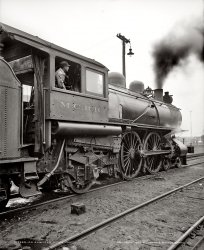
- Michigan Riviera: 1910
- ... Several landmarks stand out, all on Fort Street:
- Michigan Central Railroad Depot, on the left, demolished
- Fort ... importance to buoyancy, and who was a consultant to the Detroit, Belle Isle & Windsor Ferry Company, owners of these ferries.
... Posted by Dave - 05/12/2018 - 10:51pm -
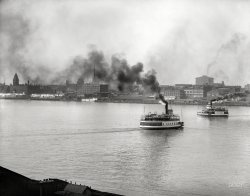
- Michigan Normal: 1902
- Ypsilanti, Michigan, circa 1902. "Starkweather Hall, Students' Christian Association, Michigan State Normal College." Not far from the Ypsi Water Tower . 8x10 ... to last. This one still exists on the campus of Eastern Michigan University per Google Maps. It is adjacent to McKenny Hall and sits ... Posted by Dave - 07/29/2012 - 6:11pm -
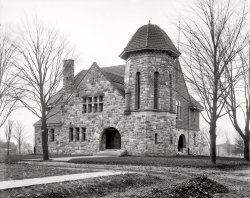
- Let's Get Fiscal: 1942
- September 1942. "Detroit, Michigan. Office worker at aircraft engine plant, Allison Division of General ... Allison Division, General Motors" with a reference to "Detroit, Michigan." But (aside from Rothstein's photos) I can find no evidence ... Posted by Dave - 10/13/2023 - 11:52am -
![Let's Get Fiscal: 1942 September 1942. "Detroit, Michigan. Office worker at aircraft engine plant, Allison Division of General Motors." Photo by Arthur Rothstein for the Office of War Information. View full size.
FridenThat is a Friden calculator. It adds, subtracts, multiplies and divides, all mechanically. The electricity just runs a motor that turns the gears. No floating point decimal though, so you have to know where it goes. Some versions of this calculator will extract square roots.
The good old Friden calculatorIn the 60's, my mother worked as a lab assistant at an agricultural experiment station, and the PhD she worked for had one of those beasts. I often visited the lab and one day after doing simple additions and subtractions on it, a decided to do a division problem. Big mistake. The machine went into gyrations while sounding like it was stripping gears. The good doctor poked his head out of his office and gave me the filthiest of looks. Later on, my mother would borrow it and haul it home so I could use it to do her taxes.
Detroit - or Indy?The Library of Congress's archives include dozens of Arthur Rothstein pictures of individual workers at an "aircraft engine plant, Allison Division, General Motors" with a reference to "Detroit, Michigan." But (aside from Rothstein's photos) I can find no evidence that such a plant was in Detroit. During WWII the Allison Division of General Motors operated large aircraft engine plants at Speedway, Indiana and nearby Indianapolis, and of course other GM divisions had plants in and around Detroit - but perhaps not the Allison Division. https://usautoindustryworldwartwo.com/General%20Motors/allison.htm
[The Cadillac plant in Detroit manufactured parts for GM's Allison Division. - Dave]
Divide by ZeroMy father used a large 9 column mechanical calculator to balance the books at our small dime store. I used to play with at times. When you tried to divide by zero it would go through some amazing mechanical spasms before it would spit out a "0.0".
Musical NumbersEverything you need to know about the Friden calculator is in this video. There is a scene with Jack Lemmon in the movie "The Apartment" working on a Friden calculator. He enters a sequence of numbers to produce the "Friden March."
(The Gallery, Arthur Rothstein, Detroit Photos, The Office)](https://www.shorpy.com/files/images/SHORPY-8d08002a.thumbnail.jpg)
- Michigan Manselet: 1910
- Circa 1910. "Morgan residence -- St. Clair Flats, Michigan." 8x10 inch dry plate glass negative, Detroit Publishing Company. ... Posted by Dave - 10/02/2016 - 4:06pm -
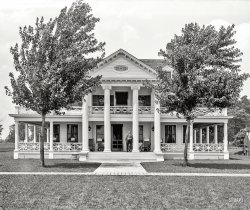
- The Detroit 200
- ... that still exists might be the oldest in the photo - the Michigan Soldiers and Sailors Monument . Its cornerstone was laid in 1867, and ... Posted by Dave - 04/15/2022 - 11:24pm -
![The Detroit 200 July 25, 1901. "Cadillac Memorial Parade -- Detroit bicentenary celebration. Floats in civic & industrial parade." Looming over the Campus Martius, the Majestic Building and one of the city's celebrated "moonlight towers." Detroit Photographic Co. glass negative. View full size.
Extent of extantThe only structure that still exists might be the oldest in the photo - the Michigan Soldiers and Sailors Monument. Its cornerstone was laid in 1867, and most of the buildings around the square were from the 1890s.
Moon TowerIf I'm not mistaken, that is a "moon tower," in the background.
[Just like it says in the photo caption! - Dave]
https://en.wikipedia.org/wiki/Moonlight_tower
Sorry, Dave! I was so excited to see the moon tower, I didn't read your caption. My mistake!
Detroit 300I found out the Soldiers' and Sailors' Monument was repositioned during a reworking of the Campus Martius plaza and rededicated at the end of that project in 2005. I'm guessing this was part of Detroit's 300 year celebration in 2001. Detroit has had a few different opera house buildings. The one in the photo now has the address of One Campus Martius, and was replaced by the building in the Google Street View with the Meridian (health insurance) name over the entrance. But Woodward Avenue still has streetcar rails.
(The Gallery, Detroit Photos, DPC, Horses)](https://www.shorpy.com/files/images/SHORPY-4a16729a.thumbnail.jpg)
- The Automobilist: 1910
- ... it might be a 1906 - 1908 Pungs-Finch (P-F) car made in Detroit, Michigan from 1904 - 1910. What first led me to this conclusion was the script ... Posted by Dave - 09/11/2023 - 3:03pm -
![The Automobilist: 1910 Detroit circa 1910. "Automobile on town street." More specifically, Jefferson Avenue at East Grand Boulevard. The building at right is Moesta's Tavern at 1407 Jefferson (also seen here). 8x10 inch glass negative, Detroit Publishing Company. View full size.
Ellie IncognitoI think this is Elinor Blevins in disguise. How many paople would own a pair of gloves like that?
Eat my dust...I've got a horseless carriage and you guys DON'T!
A pair of gloves like that?Put me down as one owner; got them about 35 years ago, kept the leather (hand) part nearly soaked in mink oil. The long fur sleeves are wonderful, used them today with the temps in the teens. Snowmobile used to call them "snot-wipers," the furry part being perfectly located for that work.
WindowsWhat are the words in the window of the building to the far right?
[Too blurry to tell. - Dave]
WHAT is the world coming to?Danged hot-rodders!
Seriously, can anyone make out the model of the car?
This looks to have been in an upper-class neighborhood. Look at the size of the houses and how clean everything was. Also, no packs of "feral children" are running wild in the streets!
Moesta's Store?The illegible shopfront sign got me curious, so I rummaged around in the LOC's Detroit Publishing Co. images that included automobiles. There are two more views of this street scene in the collection, taken at slightly different times, but each with a passing car. The LOC cataloger devised the titles from scrutiny of the original 5x7 glass negatives, listing one as "Street with automobile and Moesta's store," (LC-D418-31165) and the other as "Street with Moesta's store and Fuller Savings Bank" (LC-D418-31166). I'm not sure that the reading of "Store" is quite right, since the S-word looks longer than that in the image posted here, but the "Moesta" seems correct. There don't seem to be any other online references to these businesses, but a Moesta family genealogy page (a German surname later anglicized to Mesta) suggests Pittsburgh, PA as a possible locale for the period of the photo.
Wealth creationThe home on the left is a great house. Even when wages were only a dollar a day, there have been people that could do things that would make them rich. I think that is wonderful.
You big dummy...The driver of that car sure looks a lot like Fred G. Sanford to me...the G is for gasoline.
Early BuickMy guess on the make of automobile is A Buick Model 10 (produced from 1908 - 1911). This appears to be a runabout version without the back seat. Very sporty, no matter what.
DetroitJefferson Avenue and East Grand Boulevard. Shown below circa 1936.
Pungs-Finch?The auto looks like it might be a 1906 - 1908 Pungs-Finch (P-F) car made in Detroit, Michigan from 1904 - 1910. What first led me to this conclusion was the script lettering on the radiator - which although blurred seems to be two words. The script is certainly is not the word "Buick," but there are many similarities between the two marques.
Other identifying features in common with a P-F are the radiator shape and single strap running across the hood; tie bar below the front chassis; front axle almost directly below the radiator; rounded cowl shape and lights only on the cowl as seen in all early P-F advertising; fender line; tank or muffler below the left side chassis; and the curved body line from the top of the cowl to the front of the seat.
I am not 100% sure it is a P-F because I have not found any other photos with this exact script on the radiator or the horizontal lines running across the radiator. Everything else seems to match perfectly.
The Pungs-Fitch was made by a father and his son-in-law (W.A. Pungs and E.B. Finch). Pungs supplied the money and Finch supplied the engineering ability. They bought out the Sintz Gas Engine Company and claimed Sintz' history as their own. It is estimated that only a few hundred cars were made during their seven years in production and only two cars appear to survive.
The cars shown below are from the January 1, 1909 Cycle and Automobile Trade Journal. The fenders have been modernized, but otherwise looks nearly identical to the earlier models. Note that the Runabout and Touring Models used different hoods.
Moesta's Saloon in DetroitI found the following information online, but there was no date attached to the newspaper article nor the newspaper name.
"Detroit's most famous east side saloon, on Jefferson avenue at East Grand Boulevard since 1875, is being torn down. Formerly the headquarters of Detroit River yachtsmen, it was operated by Henry Moesta until prohibition drove him from business. His father, Henry Moesta the first, founded the tavern." Henry (the first) ran the business for about 17 years, and Henry (the second) continued on for another 23 years - roughly 1879 - 1919.
"I would have grown rich, like so many others," said Henry Moesta the second. "I preferred to obey the law like my father before me and keep always the memory of the honest place he constructed."
"The Moesta place was taken over by Harry Gordon when prohibition arrived."
"Henry Moesta's brother, Charles was also a famous tavern-keeper until prohibition arrived, when he too abandoned the business."
The story also states, "Now they are tearing the tavern down to make way for a bridge boulevard and the marine atmosphere that attached the vicinity of Jefferson avenue and East Grand Boulevard with the fresh flavor of the inland seas will never be the same again."
The street address was 1407 Jefferson Avenue which was directly across the street from the Detroit River. In the Detroit phone directory the business was described as a "Restaurant and Cafe, Imported and Domestic Wines, Liquors, and Cigars."
The photos below show the sign in front of Moesta's Saloon and a photo of part of the newspaper article showing Henry Moesta (the second) and his brother Charles Moesta along with two views of the business.
Note: This main portion of the article was very out of focus and I tried to copy everything correctly, but some words may not be correct in my quotes because reading portions of the text was so difficult.
Amazingly, there is actually a photo of the inside of the Moesta Saloon here.
(The Gallery, Cars, Trucks, Buses, Detroit Photos, DPC)](https://www.shorpy.com/files/images/SHORPY-4a18077a.thumbnail.jpg)
- Ferndale, Michigan: 1928
- Nine Mile Road just west of Detroit's main thoroughfare, Woodward Avenue. Ferndale became a boomtown in the 1920s when Henry Ford created the $5 workday wage. His factory was located a few miles south on Woodward in Highland Park.
Ferndale was ... Posted by kbreenbo - 09/19/2011 - 9:17pm -
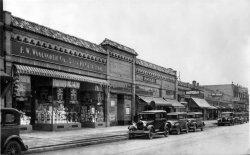
- Jackson Park: 1907
- ... Park). The German Building faced the shore of Lake Michigan, not far from the Fair's Fine Arts Building (later rebuilt as the ... Posted by Dave - 01/19/2024 - 4:39pm -
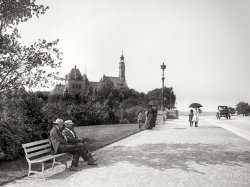
- Michigan Plungers: 1910
- Circa 1910. "Afternoon plunge, Saint Clair Flats, Michigan." 8x10 inch dry plate glass negative, Detroit Publishing Company. ... Posted by Dave - 01/21/2018 - 5:51pm -
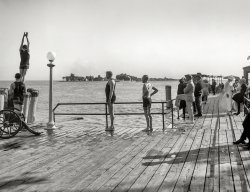
- Michigan Sugar: 1908
- 1908. "Michigan Sugar Co., Saginaw." Processor of sugar beets. 8x10 inch dry plate ... Posted by Dave - 03/31/2015 - 6:29pm -
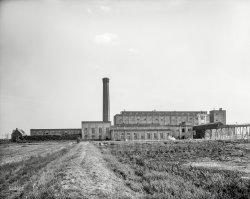
- The Heart of Detroit: 1907
- ... play "The Man of the Hour.""
D.M. Ferry and U of Michigan sports Dexter M. Ferry, the man behind the seed company in this ... and field venue, is named Ferry Field. Before today's Michigan Stadium, Ferry Field was the home of the football Wolverines, and the ... Posted by Dave - 08/29/2012 - 10:13am -
![The Heart of Detroit: 1907 Detroit circa 1907. "The Campus Martius." Landmarks include the Detroit Opera House, Soldiers' and Sailors' Monument, Cadillac Square, Wayne County Building, Hotel Pontchartrain. Panorama of three 8x10 glass negatives. View full size.
A calamity?Something big must be going on behind the Pontchartrain! A fire engine speeding left to right and dozens of men appear to be running toward the same destination. Or is it happy hour at the establishment proclaiming Kentucky Whiskey available here? Even the group of folks standing at the corner of the Hotel have their attention turned in that direction! So much going on here!
High speed photographyNo Shorpy spirits, except the sprinters already mentioned.
Concerning those lights, how much illumination did they actually cast?
Is a radio towerin the center of the picture? It appears to be a large tower.
[It's a street light. -Dave]
Horse SenseThe Motor City with more horses than motors! In back, the classic sign of economic progress -- smokin' chimneys.
Rajah CoffeeCan Starbucks be far behind?
SeedyJust sayin'
Moonlight TowerI believe that the structure in the center foreground of the photo is a moonlight tower. It was an early form of street lighting where there would be one tall tower with bright, probably carbon-arc, lights instead of multiple smaller lights closer to the ground. Austin, Texas is the only city that still has these in operation, although they have been updated to use a modern light source.
[A Shorpy favorite, seen in many of our Detroit photos, for example, here, here and here.]
re: SeedyThe Ferry Seed Warehouse seen in the background is at the western end of what is now Greektown. It's now an office building.
Women downtownI have noticed over and over on Shorpy that almost every city street scene in the northern states features women bustling about, presumably doing their shopping, having lunch with their friends, walking with their daughters, etc. In the photos of southern cities, you almost never see women on the streets. Nearly every southern city street scene comprises pretty much entirely men. Why is this? Heat? No place for "a lady" to be seen? Has anyone else noticed this?
"Man of the Hour," againAlso playing on Shorpy at https://www.shorpy.com/node/11486
The NYT called it a "Virile Melodrama," and said: "A youthful Mayor who cannot be bribed or intimidated, a financier who wants to get control of a street railway franchise in perpetuity, and a pair of political bosses, who are at odds with each other and who are fighting to gain supremacy in their organization -- these are the chief characters in George Broadhurst's play "The Man of the Hour.""
D.M. Ferry and U of Michigan sportsDexter M. Ferry, the man behind the seed company in this picture, donated the land in south Ann Arbor on which today's U of M athletic venues stand. One of which, the outdoor track and field venue, is named Ferry Field. Before today's Michigan Stadium, Ferry Field was the home of the football Wolverines, and the iron gate with the "FERRY FIELD" name remains in place on south State Street.
True CrimeAnother fantastic pic of the Campus Martius area, giving the rare view up Monroe Street where Gies's European Hotel operated (the attached building to the left of the Hotel Fowler, center of pic). In 1894, the infamous H. H. Holmes lodged Mrs. Pitezel there for a few days, the poor woman never knowing her daughters Alice and Nellie were but five blocks away.
(Panoramas, Detroit Photos, DPC, Streetcars)](https://www.shorpy.com/files/images/SHORPY_Detroit_Panorama_1.thumbnail.jpg)
- Alma Sugar: 1901
- Alma, Michigan, circa 1901. "Alma Sugar Co. factory." An early manifestation of the ... Beets" https://youtu.be/KuZNSGdg2ms
Sugar from Michigan? I never heard of Michigan sugar, so I looked it up (of course!).
... Posted by Dave - 10/15/2021 - 12:26pm -
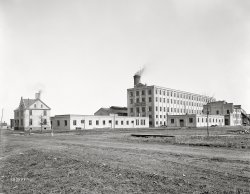
- The Library: 1901
- "University of Michigan library reading room, Ann Arbor, 1901." Detroit Publishing Company ... represent, and what does the subject have to do with Michigan? Go Blue!!!
Steam Heat What a unique shape for the radiator ... up very well against a century ago.
Heroic Figure of Michigan The sad end of the plaster statue of Michigan is described here ... Posted by Dave - 07/26/2012 - 12:31pm -
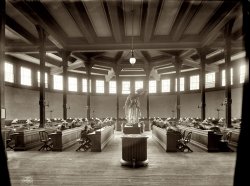
- City Hall: 1907
- Lansing, Michigan, circa 1907. "City Hall." Where the time is I:XLIII, or XVII minutes ... Spent its life - most of it anyway - in the shadow of the Michigan State Capitol (certainly figuratively and in the evening pehaps ... the MICHOP corner.
Click to embiggen.
Michigan Capitol construction They are currently installing geothermal heat ... Posted by Dave - 08/02/2022 - 12:45pm -
![City Hall: 1907 Lansing, Michigan, circa 1907. "City Hall." Where the time is I:XLIII, or XVII minutes to II. 8x10 inch dry plate glass negative, Detroit Publishing Company. View full size.
MCMLVIII: requiescat in paceSpent its life - most of it anyway - in the shadow of the Michigan State Capitol (certainly figuratively and in the evening pehaps literally). Silver Medalist in the Most Impressive Building in Town contest is apparently no guarantee of survival.
Unknown growthThe clock is interesting but what is that growth on the building to the left? Intentional? Accidental?
[That's ivy, and it's horticultural. - Dave]
Distracted informationI went to get a Google Earth view of the Lansing City Hall today and am including additional information that distracted me. The city hall is labeled in the upper right. It's much larger than was needed in 1907, plus it's all new and shiny. Then I got distracted by the construction on the capitol grounds. Looks like something is being built underground. But the front lawn is pristine green. Then I noticed there are five churches on the block just north of the capitol. The four labeled are Methodist, Christ Community, Catholic, and MICHOP. The one not labeled is Episcopal. Where I grew up a big Baptist church would occupy the MICHOP corner.
Click to embiggen.
Michigan Capitol constructionThey are currently installing geothermal heat to the Capitol, and building a museum/visitor center. The construction has been ongoing for a couple years, slowed by Covid, but fingers crossed it will be complete in about a year.
https://www.lansingstatejournal.com/story/news/2021/04/12/update-geother...
(The Gallery, Bicycles, DPC)](https://www.shorpy.com/files/images/SHORPY-4a18687a.thumbnail.jpg)
- Woodward Avenue: 1917
- Detroit, Michigan, circa 1917. "Looking up Woodward Avenue." Dry plate glass negative, ...
Hudson's Grows, and... Hudson's grew with Detroit, and perhaps inevitably, declined with Detroit.
Cascade ... Posted by Dave - 07/24/2012 - 9:50pm -
![Woodward Avenue: 1917 Detroit, Michigan, circa 1917. "Looking up Woodward Avenue." Dry plate glass negative, Detroit Publishing Company. View full size.
"Mellow as Moonlight"If I was a drinkin' man, I would be sippin' some a that Cascade whiskey.
Motor city, for sure!Not one single horse in view.
Temporal AcheMan, this is one of those Shorpy photos that really make me wish I had a time machine.
Not much leftAbout the only thing still remaining is the Soldiers' and Sailors' Monument, and even it has been moved about 300 feet from where it stood for 130 years.
An amazing photo.
Casting against TypeI see the film "Somewhere in Georgia" is playing, where Ty Cobb stars surprisingly as a small-town Georgia baseball player who signs with the Detroit Tigers.
Health InsuranceAlmost 100 years later, the country is in a major pique over health Insurance and the Detroit Creamery had the answer all along. This maybe the best urban photograph yet, it certainly is the busiest.
Notice the #2 streetcar?It's got one of those fancy-schmancy 'people scoopers' on it, like this:
https://www.shorpy.com/node/4468
HodgepodgeOne of the best urban pictures yet! Too much to take in at one sitting; The Opera House, that wonderful memorial, the traffic, those streetcars. I wonder what the tent was for in front of that fountain, just across from the Opera House.
FascinatingThere's so much to look at in this photo. I especially enjoy seeing people going about their daily lives, not posing for a camera.
The movie theater sign says "All Next Week, Somewhere in Georgia". According to IMDB.com "Somewhere in Georgia", starring Ty Cobb, was filmed in the winter of 1916 and released in June 1917. Is the 1915 date on the photo in error?
[Do we know what "circa" means? - Dave]
An Edison ElectricI notice that the Edison Electric is being driven by a woman. My grandmother (who lived in Detroit) said that the only car she ever drove was an Edison Electric. She was afraid of driving a gasoline-powered car.
[Women liked electrics because there were no gears to shift, and no clutch -- shifting and clutching on cars of that era required quite a bit of muscle. - Dave]
Cloudy crystal ballCover story in Time Magazine, October 5, 2009: "The Tragedy of Detroit: How a great city fell, and it it can rise again."
Speaking of moonlightFarewell, good moonlight towers. Twenty years gone by the time of this photo.
Is it a coincidence that Shorpy has hit upon another star of the silent screen? The theater beneath the Blackstone Cigar sign (far right)features Gladys Brockwell, who, like Kay Laurell (1890-1927), died in her thirties. Horrific 1929 car crash in California.
Merrill FountainThe Merrill Fountain in front of the Opera House still exists, too. Granted, it was moved about seven miles up the road to Palmer Park.
Before it was called Wootwart (Woodward)The definition of the "good old days" ...
Traffic LightsGreat image. Did traffic lights look different then, or did they not have them in Detroit?
[In 1917, traffic signals came on two legs. - Dave]
Re: An Edison ElectricLooks more like a Detroit Electric car than the very rare Edison.
The main reason the ladies like the electric car was no crank starting. Charles Kettering changed that a few years later with the electric starter motor if IC engines.
Notice the complete absenceof horse poop. And horses.
Stop sign doesn't apply...Surprised to see that pedestrains do not follow traffic signs as they crossed the streets. It seems that those signs were for trolleys and cars only. It anwered my question why my g-g-great uncle got killed by a trolley.
ProsperityWow! You can almost hear the hustle and bustle of prosperity in this amazing photograph -- the essence of early 20th century proud American urbanity. Go to Google Earth or some other mapping web site and visit the corner of Woodward and Fort today -- a dreary, faceless, lifeless desert of glassy highrises without a pedestrian in sight.
HeartbreakingWhen I go through Detroit now it is a vast third world, broken down, trashed city, with gangs and thugs peering from behind collapsed buildings. How in the name of all that is worthy could this magnificent American city come to what it is today? Almost makes me want to watch Glenn Beck.
Oh what a feelingI had to smirk a bit when I opened of the intersection on Google streets and the first thing I saw was a shiny Toyota.
FABULOUSThis image is go busy and wonderful. There is so much to notice. I wonder what the conversations were and so much more.
There is a tent in the middle of the square to the left of the statue. Why? What is the statue of?
All in WhiteI love the woman all in white crossing the street with her plaid skirted friend (near the front of the photo, just before the frontmost car). She looks so different than everyone else.
I bet the two women just walking into the frame below them are talking about her. She's showing ankle AND calf! I'm sure she'll be a flapper in a few years!
The girl in whiteI think that the girl in white is in fact a girl - probably a young teen accompanying her mother (the lady in the plaid skirt). Therefore she would be perfectly well dressed for her age. However that also means that she would be in the right demographic to become a flapper once the twenties (which would coincide with her twenties) rolled around.
Great picture - Lord I could look at it for hours!
That banner over the street"ENLIST NOW! YOUR COUNTRY NEEDS YOU"
And to your left...Seems even Detroit had its requisite "Seeing..." touring bus company. I count three "charabancs" in this photo, one across the street from Bond's with "WELLS" emblazoned on the back, and two in the centre-left crammed with mostly female tourists. Wonder what they were off to see next?
I'm loving the little insignificant human moments the photographer caught and immortalized: the man at the lower left trying to make something out on a bulletin board; the hefty many putting his arm around his companion's waist next to the memorial; three ladies converging outside the theater. Fantastic.
The building on the far leftis the 1896 Majestic Building, designed by the famous Chicago architect Daniel Burnham. Among other things, Burnham also designed the Flatiron Building in NYC, and oversaw the construction of the 1893 World's Columbian Exposition. The Majestic was Detroit's tallest building until 1909, when the Ford Building (also a Burnham creation) was completed. The Ford still stands today, as well as Burnham's other Detroit creations, the David Whitney Building and the Dime Building. Sadly the Majestic was torn down in 1962 to make way for the exponentially less-interesting 1001 Woodward Building.
“Make no little plans; they have no magic to stir men’s blood and probably themselves will not be realized. Make big plans; aim high in hope and work, remembering that a noble, logical diagram once recorded will not die, but long after we are gone be a living thing, asserting itself with ever-growing insistence. Remember that our sons and our grandsons are going to do things that would stagger us. Let your watchword be order and your beacon beauty.”
-Daniel H. Burnham
Sight Seeing in Detroit ca. 1917The Dietsche Sight Seeing Company was one of several companies that offered tours of Detroit back in this time period. Below is a photo of their advertisement offering their services to local companies who might want to entertain their out-of-town customers with a "Sight Seeing Trip around the city, Belle Isle, or Water Works Park."
Given the description of the street banner, this photo was probably taken sometime around June 5, 1917, which was the date on which all men between the ages of 21 and 31 were required to register for the draft.
Soldiers and Sailors MonumentStill nearby, but not as nicely maintained.
Very Nicely MaintainedThe Soldiers & Sailors monument is actually very well maintained. Notice how it's not all blackened with soot as in the old photo. When you view it up close you can also see where some very nice restoration has recently been done. Not everything in Detroit is a rotting hulk.
Still busyNot like this, but the ice skating rink at Campus Martius is already set up and would be approximately directly in front of the Detroit Opera House. Downtown Detroit is not the home of thugs or crime at all, really, but is sadly quiet when the businesses are closed. Many of the buildings are still here, and magnificent. Come visit before they tear them all down.
I'll be ordering a large print of this image! Thank you Shorpy.
Re. "Mellow as Moonlight"I saw this photo a few days ago, and, like GeezerNYC, I was quite struck by the Cascade Whiskey billboard. Now, I know that Geo. Dickel is still in business, and I was familiar with Dickel's Tennessee Sipppin' Whiskey and Old No. 8, but I had never heard of Cascade. It must have gone the way of the buggy whip and Lydia Pinkham, I thought.
But then today I stopped at the liquor store after work to pick up a bottle of wine, and GUESS WHAT THEY HAD?!?! shhhh...too loud. So, then
and I bought some. And do you guys know what? It's pretty goood. I';m drikning it right now. And I just wanna
True story I swear.
Hey! do you know what? I bought some oft hat Cacsade whiskey? Or is it whishky? Aanyway, I just wanna
You know what/ You guys are greatf. I just wanna
Hudson's Grows, and...Hudson's grew with Detroit, and perhaps inevitably, declined with Detroit.
Cascade HollowThe current Cascade Hollow Whiskey was created to deal with a shortage of the Dickel No. 8 and then just hung around. They didn't have enough whiskey of a certain age so they made a new brand and put their younger stuff in it so that the quality of the No. 8 wouldn't suffer. The Cascade Hollow has been discontinued, but it's still on the shelves in many places.
The name Cascade was replaced by the Dickel name after Prohibition and a number.
In order of price (& quality) the current Dickel offerings are:
(Cascade Hollow)
Dickel No. 8
Dickel No. 12
Dickel Barrel Select (which is one of the best whiskeys I've ever had. And I've had a lot.)
Anyway, Dickel is currently owned by the evil international spirits conglomorate Diageo, which also owns Guinness, Hennessey, Smirnoff, Johnny Walker, Tanqueray, Bushmills, Cpt. Morgan, Jose Cuervo, Crown Royal and many many more.
I can't relate to this picture at allThere is no one in this picture that looks like me or anyone else in my family and for that matter most of my friends...maybe that's how most of the people making comments about it want Detroit to look like.
Movie ID helpIn the background, there appears to be a movie showing called "The Spoilers", but Wikipedia says it came out in 1914, not 1917. Just below that it looks like "Barrymore (?) as Georgia" and to the left of that is "Ty". Anyone have some ideas as to which movies are being advertised?
[The movie is "Somewhere in Georgia," with Ty Cobb, released in 1917. - Dave]
Re: Re: An Edison ElectricMy great-great-grandfather Frank Montgomery Foster was selling Kissel Kars in Detroit. In 1913, he also had "one of the Detroit's finest garages at the corner of Gratiot Avenue and Grand Boulevard." It looks like the two cars in the bottom left of the photo (with the barrel fronts) may be Kissels, but I don't know enough about autos of the era to ID them.
KernsMy co-worker's last name is Kerns. I showed him this picture one day and eventually forwarded it to him. He then forwarded picture to his family and learned that his mother Americanized their Polish name around 1917 after seeing that building "Kern's Children's Clothes."
One of the best!The photo is insanely busy and the comments led me on a couple scavenger hunts online. Introduced to Gladys Brockwell, Daniel Burnham, Cascade, Dietsche company, etc. A very entertaining hour and a half on this one pic! Of course, being from Detroit makes it that much more interesting. Also, Heartbreaking, Detroit is a pheonix. You watch what she can do! The people have so much spirit. We love our city like a member of our family.
(The Gallery, Cars, Trucks, Buses, Detroit Photos, DPC, Streetcars)](https://www.shorpy.com/files/images/4a24908u.thumbnail.jpg)
- The Pontch Again: 1912
- Detroit, Michigan, circa 1912. "Hotel Pontchartrain." Yet another view of this ... Posted by Dave - 11/08/2023 - 5:20pm -
![The Pontch Again: 1912 Detroit, Michigan, circa 1912. "Hotel Pontchartrain." Yet another view of this relatively short-lived hostelry on Woodward Avenue, whose downfall was a paucity of private bathrooms. Familiar landmarks include the Soldiers' and Sailors' Monument, Cadillac Square and the Cadillac Chair. 8x10 inch glass negative, Detroit Publishing Company. View full size.
"Misfit"I wonder what went down at "MISFIT"? Or did they just sell irregular clothing? And what could those fellas on the corner be taking a gander at?
[Misfit was the haberdashery owned by Sol Berman at 120 Woodward Avenue. The headline below is like something out of the Onion. - Dave]
Anywhere you wantThere do not seem to be much in the way of parking regulations yet. Check out the street in front of the hotel.
Nice Cleanup DaveI downloaded the original image from the LOC a while back. You've done a very nice cleanup job for the Shorpy site! Thank you.
[Thanks, but I didn't do any "cleaning up." - Dave]
My mistake. I'm confusing this image with a sister image you've previously posted that was pretty distressed.
Cheep lodgingsHenry Ford had a purple martin bird house at his home Fairlane that he called the Hotel Pontchartrain. Don't know if Albert Kahn was the architect.
You'd Almost ThinkApparently, the plethora of windows was no offset for the paucity of bathrooms.
Street sightingOdd load waiting to cross the street. Coil of rope? Life preserver? Spare tire?
Aha! Much clearer in closeup. The fellow is obviously hefting a coil of rope headed for a nearby ship chandlery.
(The Gallery, Detroit Photos, DPC, Streetcars)](https://www.shorpy.com/files/images/4a19783a.thumbnail.jpg)
- Cadillac Square: 1902
- ... the experience encountered when traveling south out of Michigan in the dead of winter and you first experience the smell of the earth ... smoke is from those cheap cigars.
To be fair about Michigan Esteemed fellow Shorpy-ite FotoFantasist correctly mentions clean ... Posted by Dave - 02/13/2013 - 12:14pm -
